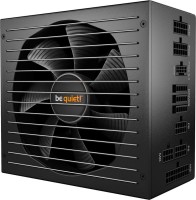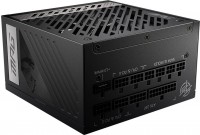What is the difference between cheap and expensive PC power supply?
We independently test the products and technologies that we recommend.

Design differences
The form factor. The most widely used format of computer power supplies is ATX (length 14-18 cm). To assemble compact PCs in a Mini-ITX case, compact TFX and SFX formats are used, for example FSP SFX PRO 450-50SAC Price from 3 361 up to 3 371 ₴ and FSP DAGGER PRO SDA2-650 Price from 4 889 up to 5 738 ₴. And for the smallest PCs (nettops or thin clients), external PSUs are used.
Power. There are at least three main power indicators of the power supply unit: the rated power claimed by the manufacturer; the +12 volt line power, which feeds the most "voracious" PC components (processor and graphics card); and peak power, that is, the maximum total load on all lines that the PSU is able to withstand. It is worth focus primarily on the second indicator — the power of the line + 12 V.
Efficiency factor. The higher the efficiency of the power supply, the more electricity is transferred from the household power outlet to the PC components, and the less it turns into useless heat. Most often, the efficiency is indicated in the form of a generally accepted 80 PLUS energy efficiency certificate (basic, Bronze, Gold, etc.). But sometimes BP manufacturers use their own energy efficiency scale.
 |
Platform. The electronic hardware of power supplies is generally called a platform or circuitry. Some manufacturers, in particular FSP companies, develop and produce a platform for their PSUs independently. Others order from third-party manufacturers (for example, from the same FSP).
Capacitors. The most rapidly wearing electronic components of the PS are electrolytic capacitors. Chinese "condors" can swell in a year or two, which will lead to power supply voltage drops. Taiwanese live an average of five years, and Japanese will serve for a whole decade.
Wires. Low-cost power supplies often have short wires, which may not be enough for hidden installation behind the back wall of the PC case. BP has more expensive cables not only long, but also in a fabric braid or in the form of flat "noodles", which further contributes to their neat laying. And in the case of a modular PSU, extra wires can be easily disconnected.
 |
Cooling. There are three main cooling schemes for power supplies. The first one is active when the fan rotates all the time, but changes speed depending on the temperature. The second is semi—passive, in which the "spinner" starts only with a certain load, for example after 30 percent. In addition, a PSU with active and semi-passive cooling can greatly vary the noise level and durability of the fan. Finally, the third is completely passive, that is, fanless, which, however, imposes a limit on the maximum power of the PSU.
Protection levels. In order for both the power supply and other PC components to serve for many years without mishaps, all basic electrical protections must be implemented. Namely: OCP and OPP from overload, OVP and UVP from high and low voltage, SCP from short circuit and OTP from overheating. Usually, a BP worth $ 50 + has all this in full volume.
Low-cost power supply

FSP PNR Pro is undoubtedly the representative of the most iconic series of computer power supplies in our region. For a good decade and a half, FSP PNR has been associated among buyers with inexpensive, but very reliable PSUs. The updated Pro version received a case in black with more thoughtful ventilation, as well as relatively long wires and more connectors. A choice of capacities from 400 to 700 watts is available, all without exception with Active PFC stabilization.
"Under the hood" of the PNR Pro is a time-tested initial FSP platform with group voltage stabilization. The efficiency reaches 85 percent, which is fully consistent with the 80 PLUS Bronze certificate. But the operation of the PSU only in European 230-volt power grids, without the support of American 110-volt ones, did not allow the PSU to receive an official certificate. However, maybe it's for the best, because it allowed to minimize the cost.
The capacitors of the PNR Pro of the middle level are Taiwanese CapXon or Teapo. However, this is even a plus, because in other low-cost blocks there are often Chinese "one-year-old" capacitors. And the use of expensive Japanese "condors" would be an unjustified waste. The fan is from Yate Loon, on a sliding bearing, with a diameter of 12 centimeters, which can also be described as a medium—level solution.
The older 700-watt version of the PNR Pro has two separate +12 volt lines with a capacity of up to 35 amps each to power the processor with the motherboard and the graphics card, respectively. Two 4-pin processor connectors are available (useful for CPU overclocking) and the same number of 6+2-pin graphics cards, which allows you to power any GPU, even the top-end GeForce GTX 2080 Ti (650+ Watt PSU is recommended on NVIDIA's official website).
There are also six SATA connectors, a pair of Molex's, and even one rare FDD connector, which, however, is still needed to power some sound cards and reobases. All wires are non-removable and without braiding, but at the same time thick, that is, the insulation will not melt one hundred percent due to overheating. In general, the FSP PNR used to be one of the best low-cost power supplies on the market, and with the release of the Pro version it became even a little more interesting for the same price.
Top-end power supply

FSP Hydro G Pro is a top—end series of computer power supplies of the famous Taiwanese brand, with a capacity from 650 to 1000 watts. The 80 PLUS Gold energy efficiency certificate was obtained thanks to the efficiency of 90 percent and the support of both European and American power grids. The latter makes the PSU useful even in our region, because it allows uninterrupted operation with strong voltage drawdowns in the 230-volt power grid, which is especially common in rural areas (up to 170 V).
The Hydro G Pro platform is fully modular, self—developed and manufactured by FSP, operating according to a more progressive DC-DC conversion scheme than group stabilization. The capacitors used are high-temperature (up to 105 °C) Japanese Nippon Chemi-Con and Rubycon, as well as United Chemi-Con (the American branch of Nippon). Taking this into account, FSP company with full confidence gives a ten-year warranty for this PSU (it may vary depending on the country).
In the 750-watt version of the Hydro G Pro, the power of the whole line +12 volts is as much as 62 amperes, that is, 750 watts, which is equal to the claimed nominal value. And in peak mode, that is, at full load on all lines (+12, +5 and +3.3 V), the PSU is able to output another hundred watts more. The high power of the PSU is confirmed by the presence of two 4+4-pin processor connectors and four 8+2-pin graphics card connectors at once.
You can power a pair of, if not top-end, then at least pre-top video cards in a bundle of CrossFire, SLI or NVLink from the 750-watt Hydro G Pro. At the same time, even under maximum load, the internal electronic components of the PSU are heated to a maximum of 50 °C, which is very far from critical temperatures. This is achieved thanks to massive aluminium radiators and strong blowing by a 12-cm fan on a durable hydrodynamic bearing.
If, under maximum load, the noise of the Hydro G Pro fan can be described as average (about the same as from a CPU cooler or a graphics card), then under a load of less than 30 percent, the PSU switches to silent passive cooling. But if desired, for example in the hot season, the Eco button on the PSU case can switch to the mode of constant light blowing. There are also mid-price power supplies in the assortment of the FSP company: FSP Hyper 80+ PRO H3-650 with a basic certificate of 80 PLUS and "bronze" FSP Hydro PRO HP2-700 .
 |
Conclusions
So which power supply — low-cost, mid—price or top-end — should you choose? To assemble an office PC with an integrated graphics card, a good low-cost PSU with a capacity of 400 – 500 watts is quite enough. The possible noise of the fan will still not be heard over the conversations of office employees. Fortunately, even low-cost modern models without the 80 PLUS certificate still have a fairly high efficiency, which will save on electricity bills. For a gaming PC with a graphics card up to GeForce RTX 2060 or Radeon RX 5600, an average-price PSU with an 80 PLUS or 80 PLUS Bronze certificate and a power of 550 – 650 watts is optimal. Thus, working at half of the maximum load, the PSU will remain quiet and cool. A top-end gaming or professional-working PC with one GeForce RTX 2080 or two RTX 2070 graphics cards will have a flagship "golden" PSU from 700 watts and above at the time. Moreover, the power in this case is inferior in importance to other parameters: the convenience of assembling a PC, thanks to flat modular wires, and hybrid cooling, minimizing noise in idle time and extending the service life of the fan.
Articles, reviews, useful tips
All materials


































